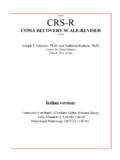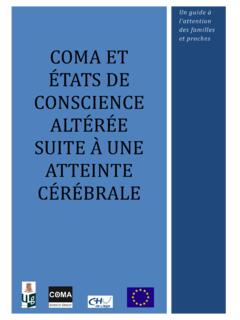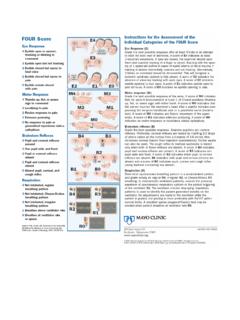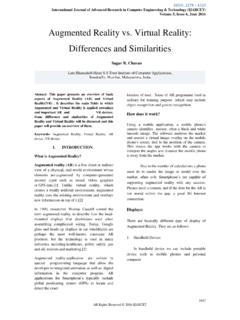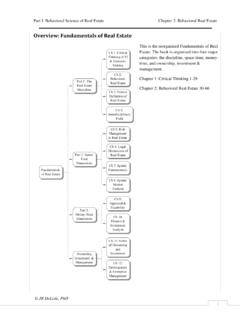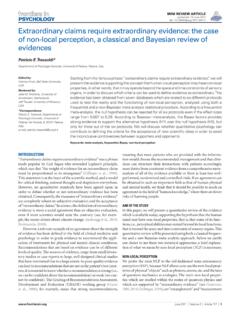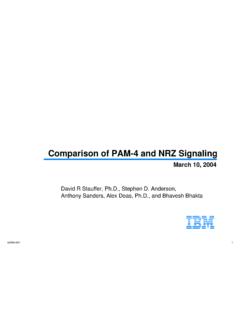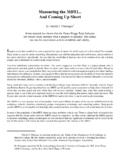Transcription of Coma
1 ComaS Laureys, M Boly, G Moonen, and P Maquet,University of Lie`ge, Lie`ge, Belgium 2009 Elsevier Ltd. All rights Dimensions of Consciousness:Arousal and AwarenessConsciousness is a multifaceted concept that hastwo dimensions: arousal, or wakefulness ( , levelof consciousness), and awareness ( , content ofconsciousness). One needs to be awake in orderto be aware (rapid eye movement (REM) sleep andlucid dreaming being notorious exceptions).Figure 1shows that in normal physiological states (green),level and content are positively correlated (with theexception of the oneiric activity during REM sleep).Patients in pathological or pharmacological coma( , general anesthesia) are unconscious because theycannot be awakened (pink). The vegetative state (VS;blue) is a unique dissociated state of consciousness( , patients are seemingly awake but lack any behav-ioral evidence of voluntary or willed behavior).There is, of course, an irreducible philosophical limita-tion in knowing for certain whether any other beingpossesses a conscious life.
2 Awareness is a subjectivefirst-person experience, and its clinical evaluation islimited to evaluating patients motor addition to its clinical and ethical importance, study-ing these disorders offers a still largely underestimatedmeans of studying human consciousness. In contrastto unconscious states such as general anesthesia anddeep sleep (in which impairment in arousal cannot bedisentangled from impairment in awareness), VS ischaracterized by a unique dissociation of arousal andawareness, offering a lesional approach to identifyingthe neural correlates of awareness. A major challengeis to unequivocally disentangle patients residing inthe clinical gray zone between the vegetative and theminimally conscious state (MCS). The locked-in syn-drome (LIS) is a rare but horrifying situation in whichpatients awaken from their coma fully aware butremain mute and immobile; it is called a pseudodis-order of consciousness because patients superficiallylook unconscious but in reality are fully aware onlyunable to show it due to severe is supported by several brain stem neuro-nal populations ( , the reticular activating system)that directly or via nonspecific thalamic nuclei projectto cortical neurons.
3 Hence, focal damage of the brainstem or diffuse damage of the cerebral hemispheresmay cause reduced arousal. The evaluation of eye-opening and brain stem reflexes is a key to the clinicalassessment of the functional integrity of the arousalsystems. Awareness depends on the functional integ-rity of the cerebral cortex and its reciprocal subcorti-cal connections (each of its aspects partly residingin spatially defined brain areas), but its underlyingneural code remains to be elucidated. Therefore thereis, at present, no validated objective consciousnessmeter. The estimation of the multiple dimensions ofconsciousness requires the interpretation of severalclinical signs, mainly based on the observation of voluntary interaction with the examiner or the envi-ronment. Brain death, coma, VS, MCS, and LIS(seeFigure 2) are all solely defined by clinical scoring systems have been developed for astandardized assessment of consciousness in severelybrain-damaged of Disorders of ConsciousnessBrain DeathBrain death means human death determined by neu-rological criteria.
4 The current definition of death isthe permanent cessation of the critical functions ofthe organism as a whole ( , neuroendocrine andhomeostatic regulation, circulation, respiration, andconsciousness). Most countries, including the US,require death of the whole brain including the brainstem, but some ( , UK and India) rely on the deathof the brain stem only, arguing that the brain stemis at once the through-station for nearly all hemi-spheric input and output, the center generatingarousal (an essential condition for conscious aware-ness), and the center of respiration. Clinical assess-ments for brain death, however, are uniform and arebased on the loss of all brain stem reflexes and thedemonstration of continuing cessation of respiration(by performing a standardized apnea test) in a persis-tently comatose patient (Table 1). There should be anevident cause of coma, and confounding factors suchas hypothermia, drugs, and electrolyte and endo-crine disturbances should be ruled death is classically caused by a massive brainlesion ( , trauma, intracranial hemorrhage, anoxia)which increases intracranial pressure to values supe-rior to mean arterial blood pressure and hence causesintracranial circulation to cease and damages thebrain stem due to herniation.
5 Using the brain stemformulation of death, however, unusual but existingcases of catastrophic brain stem lesion (often of hem-orrhagic origin) sparing the thalami and cerebral cor-tex can be declared brain death in the absence ofclinical brain stem function, despite intact intracra-nial circulation. Hence a patient with a primary brainComa1133 Encyclopedia of Neuroscience (2009), vol. 2, pp. 1133-1142 Author's personal copystem lesion (who did not develop raised intracranialpressure) might theoretically be declared dead by theUK doctrine but not by the US is a state of unarousable unresponsivenesscharacterized by the deficiency of the arousal systems(clinically assessed as the absence of stimulation-induced eye opening after having ruled out bilateralptosis) and thus also by absence of comatose patient lacks the sleep wake cyclesthat can be observed in the VS. To be clearly distin-guished from syncope, concussion, or other states oftransient unconsciousness, coma must persist for atleast 1 h.
6 In general, comatose patients who survivebegin to awaken and recover gradually within 2 4weeks. This recovery may go no further than VS orMCS, or these may be stages (brief or prolonged) onthe way to more complete recovery of are two main causes of coma: (1) bihemisphericArousalNormalconsciousnessC omaVegetativestateMinimallyconsciousstat eLocked-insyndromeAwarenessArousalAwaren essArousalAwarenessArousalAwarenessArous alAwarenessFigure 2 Graphical representation of the two dimensions of consciousness: arousal (red arrow) and awareness (green arrow) and theiralterations in coma, the vegetative state, the minimally conscious state, and the locked-in syndrome. Adapted from Laureys S, Owen AM,and Schiff ND (2004) Brain function in coma, vegetative state, and related Neurology3: 537 syndromeDrowsinessMinimally conscious stateVegetative stateGeneralanesthesiaComaLevel of consciousness: wakefulnessContent of consciousness: awarenessLight sleepDeep sleepREMsleepFigure 1 Oversimplified illustration of the two major dimensions of consciousness: the level of consciousness ( , arousal orwakefulness) and the content of consciousness ( , awareness or experience).
7 Adapted from Laureys S (2005) The neural correlateof (un)awareness: Lessons from the vegetative in Cognitive Sciences9: 556 Encyclopedia of Neuroscience (2009), vol. 2, pp. 1133-1142 Author's personal copydiffuse cortical or white matter damage secondary toneuronal or axonal injury and (2) brain stem lesionsbilaterally affecting the subcortical reticular arousingsystems ( , pontomesencephalic tegmentum and/orparamedian thalami).VSVS was defined in 1972 by Bryan Jennett and FredPlum to describe those patients who awaken fromtheir coma (meaning they open their eyes spon-taneously or on stimulation) but remain unaware ofself or environment (meaning they show only reflexmotor responses;Table 2). According to theOxfordEnglish Dictionary, the term vegetative describes an organic body capable of growth and develop-ment but devoid of sensation and thought. It isvery important to stress the difference between per-sistent and permanent VS, which are, unfortunately,too often abbreviated identically as PVS, causingunnecessary confusion.
8 Persistent VS has been arbi-trarily defined as a VS still present 1 month after theacute brain damage, but the term does not implyirreversibility. In 1994, the US Multi-Society TaskForce on PVS concluded that 3months followingnontraumatic brain damage and 12 months aftertraumatic injury, the condition of VS patients maybe regarded as permanent. Only in cases of perma-nent VS do the ethical and legal issues surroundingwithdrawal of treatment arise. It is essential thatexperienced examiners employing adapted standar-dized clinical assessment scales repeatedly establishthe behavioral absence of any sign of consciousperception or deliberate action before making thediagnosis of 2002, the Aspen Neurobehavioral ConferenceWorkgroup published the diagnostic criteria for MCSto subcategorize patients above VS but unable tofunctionally communicate their thoughts and a reproducible or sustained basis, MCS patientsshow limited but clearly discernible evidence of aware-ness of self or environment (Table 3).
9 The emergenceof MCS is characterized by the recovery of interactivecommunication or functional use of objects. Furtherimprovement is more likely than in VS patients. How-ever, some patients may remain permanently in present, no time intervals for permanent MCS have been agreed on. Akinetic mutism (a condition characterized bysevere poverty of movement, speech, and thoughtwithout associated arousal disorder or descendingTable 1 Criteria for brain death (American Academy ofNeurology guidelines) Demonstration of coma Evidence for the cause of coma Absence of confounding factors, including hypothermia, drugs,electrolyte, and endorcrine disturbances Absence of brain stem reflexes Absent motor responses Apnea A repeat evaluation in 6 h is advised, but the amount of time isconsidered arbitrary Confirmatory laboratory tests are required only when specificcomponents of the clinical testing cannot be reliably evaluatedTable 2 Criteria for the vegetative state (US Multi-Society TaskForce on Persistent Vegetative State guidelines))
10 No evidence of awareness of self or environment and aninability to interact with others No evidence of sustained, reproducible, purposeful, or voluntarybehavioral responses to visual, auditory, tactile, or noxiousstimuli No evidence of language comprehension or expression Intermittent wakefulness manifested by the presence ofsleep wake cycles Sufficiently preserved hypothalamic and brain stem autonomicfunctions to permit survival with medical and nursing care Bowel and bladder incontinence Variably preserved cranial nerve and spinal reflexesTable 3 Criteria for the minimally conscious state (AspenNeurobehavioral Conference Workgroup)Clearly discernible evidence of awareness of self or environment,on a reproducible or sustained basis, by at least one of thefollowing behaviors: Purposeful behavior (including movements or affective behaviorthat occurs in contingent relation to relevant environment stimuliand are not due to reflexive activity), such as: Pursuit eye movement or sustained fixation occurring in directresponse to moving or salient stimuli Smiling or crying in response to verbal or visual emotional (butnot neutral) stimuli Reaching for objects demonstrating a relationship betweenobject location and direction of reach Touching or holding objects in a manner that accommodatesthe size and shape of the object Vocalizations or gestures occurring in direct response to thelinguistic content of questions Following simple commands Gestural or verbal yes/no response (regardless of accuracy) Intelligible verbalizationEmergence from the minimally conscious state requires reliableand consistent demonstration of at least one of the followingbehaviors: Functional interactive communication: accurate yes/noresponses to six of six basic situational orientation questions(including items as, Are you sitting down?)
